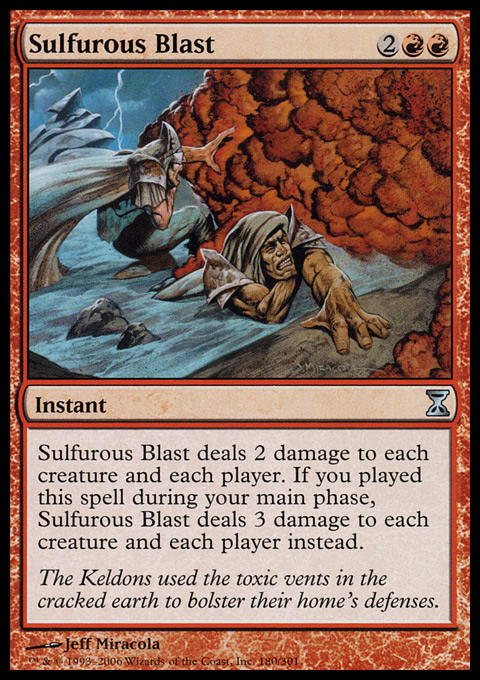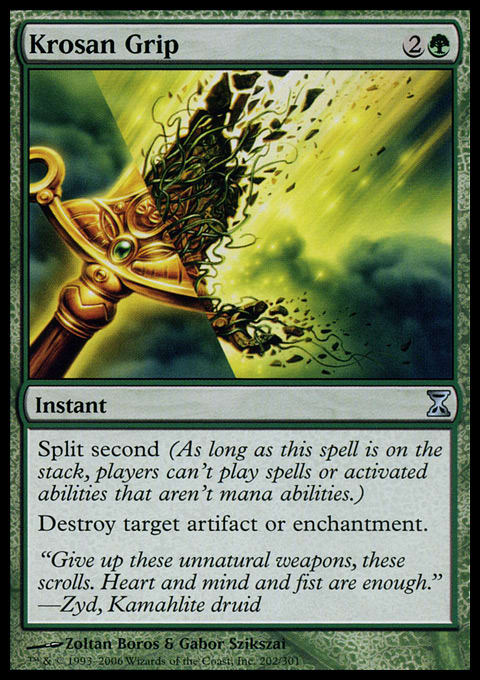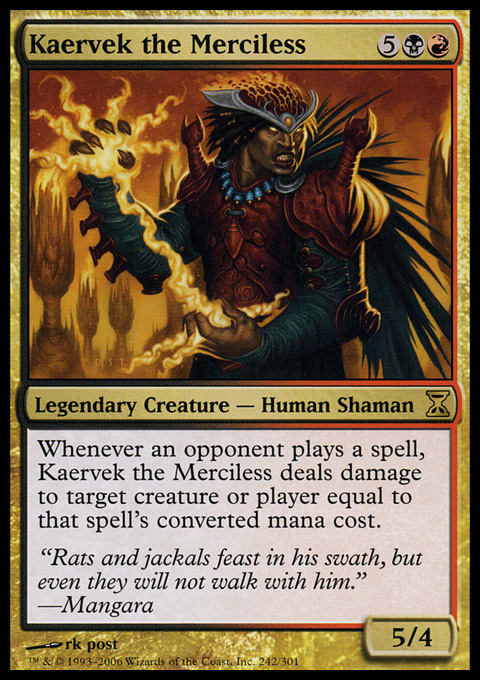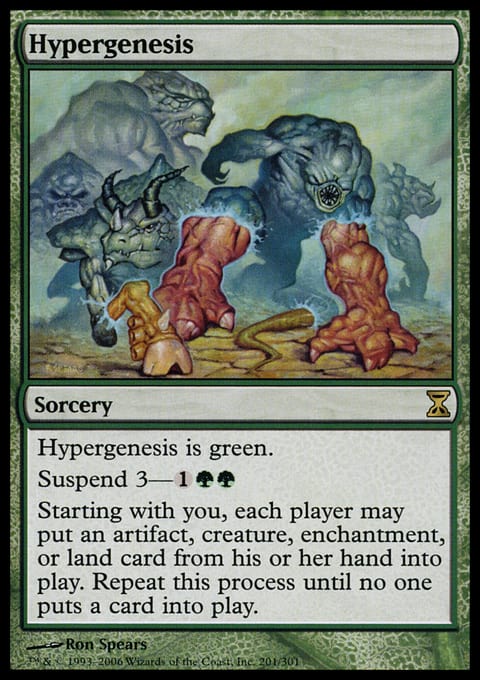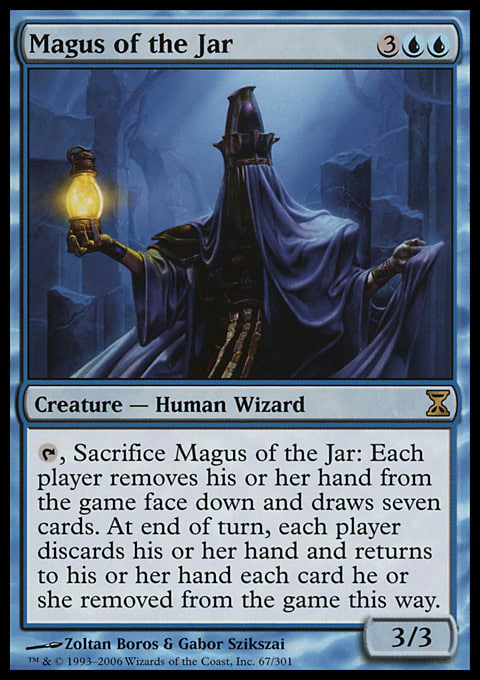Time Spiral block is my favorite block by far. Despite not playing a whole lot when it came out (stupid law school taking away from what matters), my casual decks contain more Time Spiral block than any other single block, even counting common dual lands from the Ravnica blocks. The callbacks and intricacies lead more commons to be playable than most blocks, where the Draft fodder's a bit clearer.
But none of that bears directly in assessing the block's flagship cycles. There are so many cycles that Time Spiral gets its own article, with Planar Chaos and Future Sight reserved for a future article.
A reminder of the Tour de Cards rules:
- I’m looking at horizontal cycles (Titans), not vertical cycles (Penumbra Bobcat/Penumbra Kavu/Penumbra Wurm). They need at least five cards, though they don’t have to be in five colors.
- No all-common cycles. They tend to be boring.
- No land/mana cycles. They tend to be too similar for my purposes. Besides, every dual land is good.
I’m grading each cycle on three categories:
- Playability – Does this cycle have any cards people want to play?
- Depth – Was it hit-and-miss or strong overall?
- Resonance – Memorable cycles should be able to pass the flavor test, although some cycles are mechanical and are not intended to have shared flavor. Still, making all the cards cost the same, have similar names, or share other characteristics can make a cycle memorable when it otherwise wouldn’t be.
Some Slivers
(Quilled Sliver, Telekinetic Sliver, Vampiric Sliver, Fury Sliver, Might Sliver)
Playability: B+
Depth: B
Resonance: B (Hard to fail resonance with Slivers)
Fury and Might Sliver were reprinted in Premium Deck: Slivers, and they're the two best of the cycle. Global double strike and +2/+2 are worthwhile, and until Bonescythe Sliver and Megantic Sliver, these were two of the best Slivers at bringing the beats. Vampiric Sliver in my experience has been filler; I have no experience with Telekinetic Sliver, but it looks reasonable. Quilled Sliver is a full star worse in Gatherer community ratings than the rest of the cycle, and that's what I would expect reading it.
Apart from just being Slivers, there don’t seem to be specific callbacks in this cycle; the reference is Slivers generally. The cycle's all right with some highlights, which is often what an uncommon cycle is, as boring as that sounds.
Ally-Colored Slivers
(Opaline Sliver, Dementia Sliver, Ghostflame Sliver, Firewake Sliver, Harmonic Sliver)
Playability: A−
Depth: C
Resonance: B
Better known as Harmonic Sliver and the rest, this cycle gives Slivers abilities from other cards. The cards seem chosen from strange places, but they generally are reasonable abilities. Opaline Sliver learned tricks from Rayne, Academy Chancellor, while Dementia Sliver studied under Nebuchadnezzar. Ghostflame Sliver enchants your Slivers with—imagine this!—Ghostly Flame; Firewake Sliver borrows the Fires of Yavimaya; and Harmonic Sliver is Aura Shards come to life. These are about as playable as the mono-colored cycle above, but the abilities allow more creative approaches.
Harmonic Sliver is best known, not only as a Sliver but with Birthing Pod in Modern, putting it in the approximately two percent* of all creatures discussed as viable Birthing Pod targets that ends up used as one.
*Actual figure subject to change and not valid in some metagames. See your local store for details.
The Repeat Auras
(Spirit Loop, Fool's Demise, Fallen Ideal, Undying Rage, Aspect of Mongoose)
Playability: B
Depth: B−
Resonance: C
I'm starting to see that Resonance is weird with this block. The individual cards are resonant with older individual cards, but as a cycle, this is strictly mechanical. Calling back to Spirit Link, False Demise, Fallen Angel, Maniacal Rage, and Nimble Mongoose, the Auras return to your hand when they hit the graveyard.
So, most of the question is whether the Aura effects are worth repeating. Fool's Demise is my favorite for all formats of multiplayer, as it’s a slow-motion repeatable Rise from the Grave in blue. The ones that aren't Undying Rage have niche uses, and given their repeatability, this cycle may have gained playability from heroic. Based on card prices and Gatherer ratings, I'm underselling this cycle, so try it for yourself.
Instants of the Main Phase
(Return to Dust, Careful Consideration, Haunting Hymn, Sulfurous Blast, Might of Old Krosa)
Playability: B+
Depth: B+
Resonance: B-
It's a mechanical cycle, so I'd normally just give a C for Resonance, but the flavor texts impressed me enough to give an extra mark. These spells are best in your main phase—so much better that it's rare to see them cast on an end step. Careful Consideration's the exception; you sometimes want to discard an extra card, and drawing four cards on an end step for 4 mana is worth something anyway.
Might of Old Krosa is among the best 1-mana pump spells ever printed, which is a code word for "fun in Modern infect decks." Return to Dust is a Commander staple, Sulfurous Blast was a sideboard card in Standard R/G snow decks, and several blue decks of the era ran Careful Consideration. Not a bad history for a non-flashy cycle.
Quick! It’s a Spell!
(Celestial Crusader, Wipe Away, Sudden Death, Sudden Shock, Krosan Grip)
Playability: B+
Depth: A−
Resonance: B−
As I remember it, this cycle was among the loudest in proclaiming Wizards of the Coast's love for nonblue colors. I became excited at my spells doing cool things such as resolving and having effects (absent Voidmage Apprentice or Willbender). And that functionality continues to give them playability. Krosan Grip's best known in older formats; it's the slow-but-sure option for any metagame where it's available. Sudden Death and Sudden Shock are less used but carry similar value.
Celestial Crusader and Wipe Away aren't chumps either. In my Magic Online days, I played the control head of a Two-Headed Giant Extended tournament and wound up facing two players with identical U/B control decks running Pact of Negation and Slaughter Pact just to make life worse. I had insisted on Wipe Away as the last card to make the deck, and we won because I was able to bounce a Teferi, Mage of Zhalfir with a Counterspell in my hand.
Resonance is odd on this cycle due to Celestial Crusader. The art is strong on the spells, showing instant change (took me a long time to know/notice that), but Celestial Crusader has nothing to portray in that style, making it the odd one out. But ultimately, that is a dent on an easily memorable and playable cycle.
Quicker! It’s Rarer Spells!
(Angel's Grace, Trickbind, Sudden Spoiling, Word of Seizing, Stonewood Invocation)
Playability: B+
Depth: A−
Resonance: C
I wish they hadn't bothered with the one-word flavor text on Word of Seizing and the sing-song poem on Stonewood Invocation; just admit it's a mechanical cycle with some generally-related art, and move on. But at least the rare split second cycle is highly playable. On the competitive side, Angel's Grace has keyed several Ad Nauseam–style combo decks in Modern over the years, and Stonewood Invocation saw Standard play in G/W builds of the era (with Might of Old Krosa sometimes). Casually, Trickbind joins Stifle and Voidslime in the land of countering triggered abilities, Word of Seizing sees a some Commander play, and Sudden Spoiling—my personal favorite—should see more Commander play as a premier spell that says, "In response, you screwed yourself over too."
Split second is better remembered from Time Spiral block than suspend is because all its cards were good. Of course, a lot of that was because they had split second on them, so it's a self-reinforcing kind of deal.
Some Rarer Slivers
(Pulmonic Sliver, Psionic Sliver, Plague Sliver, Sedge Sliver, Fungus Sliver)
Playability: A−
Depth: ?
Resonance: B−
I have no idea how to rate the Depth on this cycle because Plague Sliver as Juzam Djinn for Slivers is meant to antagonize the rest of the cycle. When the cycle is consciously broken, what do I do with that? That said, these feel like the forgotten Slivers; I've rarely seen them from any Sliver player despite their being quite good. Pulmonic Sliver turns Slivers into Avenging Angels and tends to feel unbeatable as a result; Slivers are hard enough to kill without having a second chance at life. Fungus Sliver is based on Fungusaur and is similarly cool but niche; this cycle's reputation is probably harmed by Fungus Sliver being the only reprint so far.
Sedge Sliver, hearkening back to Sedge Troll, was the first preview card of Time Spiral, and while it never fulfilled its implied promise, it's among the best early Slivers you can play. Its main drawback is pulling your Sliver deck toward B/R, which makes it awkward for many. Last but not least is Psionic Sliver, which, unlike the Psionic Entity that inspired it, can be fantastic, as it's the best way to win with Slivers outside combat. It's not hard to give Slivers enough toughness to survive dealing damage to themselves, and tapping each Sliver for 2 damage to an opposing face is high-quality.
If I were building a non-M14 Sliver deck, I'd build around Pulmonic, Psionic, or Sedge Sliver. They're worth tracking down if you like Slivers.
Legends of the Hidden Timeshift
(Ith, High Arcanist, Dralnu, Lich Lord, Kaervek the Merciless, Stonebrow, Krosan Hero, Saffi Eriksdotter)
Playability: A−
Depth: A−
Resonance: A−
Legendary creatures bringing storyline characters to cards, these have been given most of their legacy through Commander, where Kaervek, Stonebrow, and Saffi are popular commanders. Dralnu gave his name to Guillaume Wafo-Tapa's Standard deck Dralnu du Louvre, while Saffi Eriksdotter combined with Crypt Champion for Project X, another French-associated deck. I played Dralnu in a Standard deck that flashed back Holy Day effects; this was not nearly as good, but it was sweet.
According to the MTG wiki, Stonebrow is part of the Kamahl–Jeska story; I didn't know that until I looked it up. The others have cards associated with them. Ith has a Maze, Kaervek has a Hex, a Purge, a Torch, and some Spite, Dralnu has a Pet and a Crusade, and Saffi doesn't want the Lhurgoyf she has. It would have been great if the R/G legend of the cycle had been on a card, but it's a great cycle regardless.
The Classics: Remorphed
(Weathered Bodyguards, Vesuvan Shapeshifter, Liege of the Pit, Fortune Thief, Thelonite Hermit)
Playability: A−
Depth: B−
Resonance: A
This is a dream cycle for the nostalgic Melvin in your life. (Given that you're reading this article, the nostalgic Melvin in your life right now is definitely me.) Take an old card (Veteran Bodyguard, Vesuvan Doppelganger, Lord of the Pit, Ali of Cairo, and Deranged Hermit), give them all morph, and change the mana costs, and you get the gist of Time Spiral. And although the cycle's not well-balanced (was there nothing better than Veteran Bodyguard?), the high end is good. Vesuvan Shapeshifter was in the Pickles combo that was as good in Standard as in multiplayer—since it affects each opponent. Saproling players often love Thelonite Hermit, and I irrationally love Fortune Thief. So, there's something for everybody—Spikes, Saproling players, and me.
You Can’t Cast These Spells . . .
(Restore Balance, Ancestral Vision, Living End, Wheel of Fate, Hypergenesis, Lotus Bloom)
Playability: A
Depth: A−
Resonance: A−
When this cycle—the suspend-plus-old-cards variant of the morph-plus-old-cards cycle above—came out, only Ancestral Vision and Lotus Bloom were sufficiently playable on their own, and that makes sense; the Power Nine with suspend should still be good cards, better than Balance, Living Death, Wheel of Fortune, and Eureka that inspired the others. But two things combined to bring playability to the others in time. First was a rules change that these cards brought in, which was that cards without mana costs could be cast from other zones. At the time, this allowed suspend to work and made Evermind even stranger than it was. But in 2009, cascade showed up and made the uncheatable cards cheatable. Now, Ancestral Vision and Hypergenesis are banned in Modern, and Lotus Bloom was close, given its visibility in Eggs before Second Sunrise got the axe instead.
When half your cycle is banworthy, that's saying something, even if a later mechanic is to blame. Still, that's what happens when you put powerful effects on cards: Sometimes, a thing comes along to abuse the effect and make junk rares expensive overnight (Dark Depths? Daybreak Coronet? Search the City in an alternate universe?). The cycle was already memorable for breaking Magic rules of castability, showing off the new mechanic, working in references to old, powerful cards, and seeing tournament play, but cascade made the cycle unforgettable.
. . . But You Can Cast These Spells a Lot
(Evangelize, Walk the Aeons, Demonic Collusion, Reiterate, Wurmcalling)
Playability: B
Depth: B
Resonance: B
This cycle rates better on paper than it plays. This is supposed to be buyback on several classic cards, but while Walk the Aeons, Demonic Collusion, and Reiterate come from Time Walk, Demonic Tutor, and Fork, respectively, Evangelize comes from Preacher, and it isn't clear what Wurmcalling comes from. Reiterate is the most playable, Evangelize is the hardest to use due to weird targeting rules, and Walk the Aeons has the best art callback. But this cycle just doesn't pack enough punch to be classic.
Magi of the Artifacts
(Magus of the Disk, Magus of the Jar, Magus of the Mirror, Magus of the Scroll, Magus of the Candelabra)
Playability: B+
Depth: B
Resonance: B+
Making classic artifacts into creatures was great nostalgia. Like the suspend and morph remixes above, the Magi afforded an elegant balancing opportunity by recosting powerful abilities onto objects with summoning sickness and toughness. Magus of the Scroll served the Grim Lavamancer role for its era's mono-red decks, Magus of the Disk gets Commander love, and Magi of the Jar and Candelabra enable odd combos just as their artifact namesakes have always done (Magus of the Candelabra with Umbral Mantle is a combination anyone can love—or something). I suspect Magus of the Mirror has some good plays in it—I enjoy Soul Conduit as a Commander rattlesnake—but I've rarely if ever seen one, and black's a strange color for it.
The Resonance is not only from the clearly understood callbacks by the name and card type but by the art referencing the objects from which the abilities are timeshifted. It distracts me that Magus of the Disk looks like he's holding a Laserdisc specifically (![]() , T: Destroy all VHSs, 8-tracks, and 78 RPM vinyls), but he is supposed to be holding a weird, round object, so I guess that comparison's inevitable.
, T: Destroy all VHSs, 8-tracks, and 78 RPM vinyls), but he is supposed to be holding a weird, round object, so I guess that comparison's inevitable.
Conclusion
Time Spiral injected loads of flavor into its cycles. These weren't design-only cycles in the way of Invasion Battlemages or Dissension split cards; even if the cycle was mechanical, there was still a way to tie flavor in. When that flavor was consistently applied and/or when the mechanics tied together strongly, the cycles were superb. Absent one or the other, the cycles felt off. Time Walk with buyback and related art sounds awesome, but why Preacher with buyback? Still, better to be erratically brilliant than not brilliant at all, and its cycles usually show why many, including myself, adore the block.



















